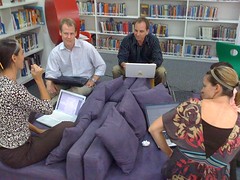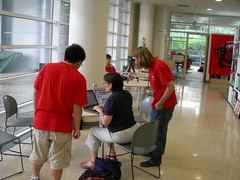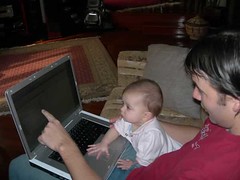 Something has stuck with me for the last few weeks and I feel the need to vent it out…maybe that’s what a blog is for!??!
Something has stuck with me for the last few weeks and I feel the need to vent it out…maybe that’s what a blog is for!??!
A good friend of mine’s younger brother (who I will forever think of as a sixth grader-that’s how old he was when I met him) just graduated from a well regarded teacher training institution. He decided that he wanted to give the overseas teaching a go and attended the ISS fair in Philadelphia. He was hired (had many interviews actually) and will teach his first two years overseas.
Prior to the career fair, he sat down with me to ‘prepare’ for the interviews. I spent some time sharing with him my experiences overseas and what life has been like. I also shared with him what I felt would be priorities with the recruiters he would be interviewing with. Chief among these was the use of and comfort with technology. I explained that understanding things like blogs, wikis, podcasts, etc and how to integrate them into his classroom would be a huge boon for him in his interviews. After a few minutes of him listening to me, I realized that his face was slowly changing and showing the beginning signs of panic. I stopped and queried “You do know how to use these tools in your classroom, right?” Sheepishly he shared that while he knew what those tools were, and used many of them in his personal life, he had never actually been taught to use them in his education program. Now it was my turn to have the color drain from my face and the beginnings of panic to set in.
 How in the world can we be turning out brand spanking new teachers that have never experimented with these tools in their training? How can any higher education program claim to be training 21st Century Teachers and yet still be graduating students with little to no exposure of current trends in technology? The university he graduated from has one of the best reputations for an education program in the entire state…how is this disconnect happening?
How in the world can we be turning out brand spanking new teachers that have never experimented with these tools in their training? How can any higher education program claim to be training 21st Century Teachers and yet still be graduating students with little to no exposure of current trends in technology? The university he graduated from has one of the best reputations for an education program in the entire state…how is this disconnect happening?
I used to think that we needed to dump all of our resources and energy into schools and professional development for current teachers. Now I’m afraid I was overlooking an incredible opportunity to fight the battle from the ‘ground up.’ What if all of the new graduates coming out of teacher training programs already had adopted this ‘paradigm shift’? What if they went into schools automatically teaching and collaborating in the ways of the 21st Century? Then they could share with the current teachers and influence students in this new landscape of learning.
This is not a new idea, I know (remember, most of what I could ever possibly say or think of is really old news-see my first blog post “Maybe Blogging Isn’t For Me…”). In searching to see what other people were and were not saying about education programs, I came across this article on the Milken Family Foundation website: Information Technology Underused in Teacher Education. In the article, there is a quote from Dr. David Moursund of the International Society for Technology in Education. He said:
“In the past few years, the preservice teacher education programs have made substantial progress in preparing future teachers in information technology, but they still have a long way to go”
The article goes on to share the results of a survey given to faculty members in teacher training programs. The survey asked the faculty about the extent to which future teachers are being exposed to technology. The survey results showed that:
“The majority of faculty-members revealed that they do not, in fact, practice or model effective technology use in their classrooms.”
The conclusion of the article is a direct quote from Cheryl Lemke, Executive Director of the Milken Exchange on Education Technology:
“The findings in this report should be a wake-up call for higher education institutions and policymakers across the country – today’s students live in a global, knowledge-based age, and they deserve teachers whose practice embraces the best that technology can bring to learning.”
 Sadly, this article was published exactly 10 years ago…seems maybe not enough people read it, or believed it! I keep finding myself becoming discouraged and disheartened. When will education put its foot to the accelerator? What will it take to get future educators prepared and in the driver’s seat? How do we get this car in gear???
Sadly, this article was published exactly 10 years ago…seems maybe not enough people read it, or believed it! I keep finding myself becoming discouraged and disheartened. When will education put its foot to the accelerator? What will it take to get future educators prepared and in the driver’s seat? How do we get this car in gear???
 I am finding myself contemplating the future of education and wondering where it’s going. I know where I think it should be headed, where I’d like it to be going…yet, somehow I don’t know if it will get there.
I am finding myself contemplating the future of education and wondering where it’s going. I know where I think it should be headed, where I’d like it to be going…yet, somehow I don’t know if it will get there. This was something I encountered at the
This was something I encountered at the  “But resisting today’s digital technology will be truly lethal to our children’s education.”
“But resisting today’s digital technology will be truly lethal to our children’s education.” As
As  My mother and I are sitting on the
My mother and I are sitting on the  “The dolphins, accompanied by a handler in small power boats, work at night. If they find an intruder, they swim back to the boat and alert the handler, who places a strobe light on their nose. The dolphin races back and bumps the intruder’s back, knocking the light off. The light floats to the surface, marking the spot.”
“The dolphins, accompanied by a handler in small power boats, work at night. If they find an intruder, they swim back to the boat and alert the handler, who places a strobe light on their nose. The dolphin races back and bumps the intruder’s back, knocking the light off. The light floats to the surface, marking the spot.”
 Having been exposed over the years (often against my will) to anything tech related, like
Having been exposed over the years (often against my will) to anything tech related, like  How does this impact our job as counselors? Our role is to assist in preparing students with the skills and attitudes to be successful in life. How do we help students to develop the necessary skills when things are changing so quickly we can’t possibly know what the world will be like? It’s a daunting thought for sure.
How does this impact our job as counselors? Our role is to assist in preparing students with the skills and attitudes to be successful in life. How do we help students to develop the necessary skills when things are changing so quickly we can’t possibly know what the world will be like? It’s a daunting thought for sure. Truth and bias are things we have always struggled with addressing in a classroom, aren’t they? They really are not new concepts that we now have to figure out.
Truth and bias are things we have always struggled with addressing in a classroom, aren’t they? They really are not new concepts that we now have to figure out.  Clarence
Clarence